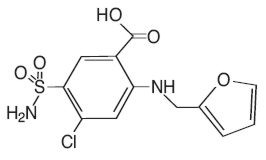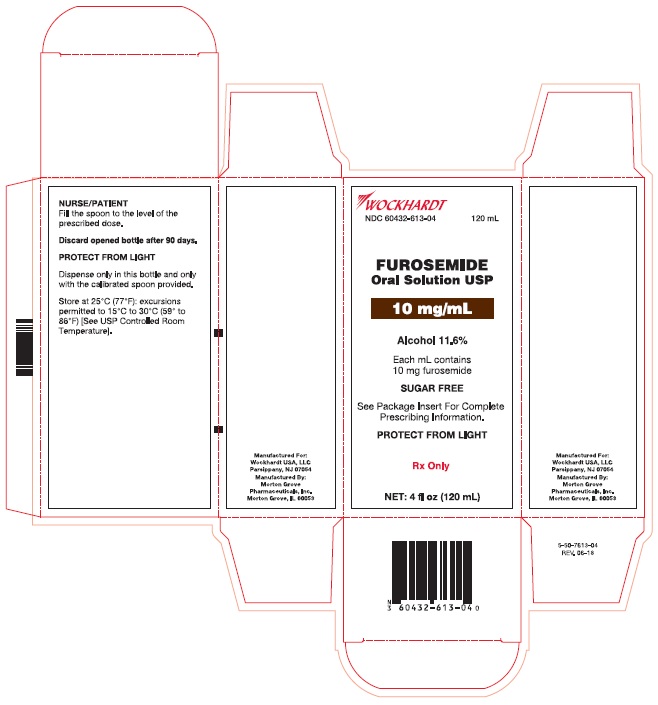Drug Catalog - Product Detail
FUROSEMIDE ORAL SOLUTION SOL 10MG/ML 118ML
| NDC | Mfr | Size | Str | Form |
|---|---|---|---|---|
| 60432-0613-04 | MORTON GROVE PHARMACEUTICALS | 120 | 10MG/ML | SOLUTION |
PACKAGE FILES


Generic Name
Substance Name
Product Type
Route
Application Number
Description
DESCRIPTION Each mL of Oral Solution for oral administration contains: Furosemide, USP.....................................10 mg per mL Alcohol ....................................................11.6% Furosemide is a diuretic which is an anthranilic acid derivative. Chemically, it is 4-chloro- N -furfuryl-5-sulfamoylanthranilic acid. Furosemide is a white to off-white, odorless, crystalline powder. It is practically insoluble in water, sparingly soluble in alcohol, freely soluble in dilute alkali solutions and insoluble in dilute acids. The CAS Registry Number is 54-31-9. The structural formula is as follows: Furosemide Oral Solution, USP is available for oral administration containing 10 mg per mL. The oral solution contains the following inactive ingredients: Dehydrated alcohol, D&C Yellow No. 10, FD&C Yellow No. 6, glycerin, hydrochloric acid, natural and artificial orange juice flavor, purified water, sodium hydroxide and sorbitol solution. It may contain 10% hydrochloric acid solution or 10% sodium hydroxide solution for pH adjustment. The pH range is between 7.0 and 9.0. furosemide01
How Supplied
HOW SUPPLIED Furosemide Oral Solution USP, 10 mg/mL is supplied as orange-flavored liquid in plastic bottles of 2 fl oz (60 mL) accompanied by a graduated dropper and plastic bottles of 4 fl oz (120 mL) accompanied by a graduated dispensing spoon. 2 fl oz (60 mL) NDC 60432-613-60 4 fl oz (120 mL) NDC 60432-613-04 RECOMMENDED STORAGE NOTE: Store at 25°C (77°F): excursions permitted to 15°C to 30°C (59° to 86°F) [See USP Controlled Room Temperature]. Dispense in original or tight, light-resistant containers as defined in the USP with graduated dropper or graduated spoon (dropper graduated in 5 mg increments at 5, 10, 15, and 20 mg corresponding to 0.5, 1, 1.5, and 2 mL; dispensing spoon graduated in 20 mg increments at 20, 40, 60, and 80 mg corresponding to 2, 4, 6, and 8 mL). Discard opened bottle after 90 days. PROTECT FROM LIGHT
Indications & Usage
INDICATIONS AND USAGE Edema Furosemide is indicated in adults and pediatric patients for the treatment of edema associated with congestive heart failure, cirrhosis of the liver and renal disease, including the nephrotic syndrome. Furosemide is particularly useful when an agent with greater diuretic potential is desired. Hypertension Oral furosemide may be used in adults for the treatment of hypertension alone or in combination with other antihypertensive agents. Hypertensive patients who cannot be adequately controlled with thiazides will probably also not be adequately controlled with furosemide alone.
Dosage and Administration
DOSAGE AND ADMINISTRATION Edema Therapy should be individualized according to patient response to gain maximal therapeutic response and to determine the minimal dose needed to maintain that response. Adults The usual initial dose of furosemide is 20 to 80 mg given as a single dose. Ordinarily a prompt diuresis ensues. If needed, the same dose can be administered 6 to 8 hours later or the dose may be increased. The dose may be raised by 20 or 40 mg and given not sooner than 6 to 8 hours after the previous dose until the desired diuretic effect has been obtained. The individually determined single dose should then be given once or twice daily (e.g., at 8 am and 2 pm). The dose of furosemide may be carefully titrated up to 600 mg/day in patients with clinically severe edematous states. Edema may be most efficiently and safely mobilized by giving furosemide on 2 to 4 consecutive days each week. When doses exceeding 80 mg/day are given for prolonged periods, careful clinical observation and laboratory monitoring are particularly advisable (See PRECAUTIONS: Laboratory Tests ). Geriatric Patients In general, dose selection for the elderly patient should be cautious, usually starting at the low end of the dosing range (See PRECAUTIONS: Geriatric Use ). Pediatric Patients The usual initial dose of oral furosemide in pediatric patients is 2 mg/kg body weight, given as a single dose. If the diuretic response is not satisfactory after the initial dose, dosage may be increased by 1 or 2 mg/kg no sooner than 6 to 8 hours after the previous dose. Doses greater than 6 mg/kg body weight are not recommended. For maintenance therapy in pediatric patients, the dose should be adjusted to the minimum effective level. Hypertension Therapy should be individualized according to the patient's response to gain maximal therapeutic response and to determine the minimal dose needed to maintain the therapeutic response. Adults The usual initial dose of furosemide for hypertension is 80 mg, usually divided into 40 mg twice a day. Dosage should then be adjusted according to response. If response is not satisfactory, add other antihypertensive agents. Changes in blood pressure must be carefully monitored when furosemide is used with other antihypertensive drugs, especially during initial therapy. To prevent excessive drop in blood pressure, the dosage of other agents should be reduced by at least 50 percent when furosemide is added to the regimen. As the blood pressure falls under the potentiating effect of furosemide, a further reduction in dosage or even discontinuation of other antihypertensive drugs may be necessary. Geriatric Patients In general, dose selection and dose adjustment for the elderly patient should be cautious, usually starting at the low end of the dosing range (See PRECAUTIONS: Geriatric Use ).
